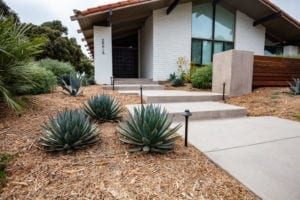Gardening in Orange County, California, presents both opportunities and challenges, given its Mediterranean climate with mild, wet winters and hot, dry summers. Mulching is a common technique employed by gardeners to overcome these challenges.
In this comprehensive guide, we will explore the pros and cons of mulching in your Orange County garden to help you make informed decisions about this essential gardening practice.
The Pros of Mulching
1. Weed Suppression
Mulch acts as a natural weed barrier, shading the soil and preventing weed seeds from germinating. This reduces the time and effort spent on weeding, allowing you to focus on enjoying your garden.
2. Moisture Retention
Orange County’s water scarcity issues make water conservation paramount. Mulch serves as a protective layer, significantly reducing water evaporation from the soil. This is especially valuable during the scorching summer months.
3. Soil Erosion Control
Mulch plays a crucial role in preventing soil erosion, particularly during the region’s mild winters. By covering the soil surface, it minimizes the impact of raindrops and protects valuable topsoil.
4. Temperature Regulation
Mulch insulates the soil, stabilizing root temperatures. This is especially helpful for plants sensitive to extreme temperatures during early and late crop seasons.
5. Enhanced Soil Health
Organic mulches enrich the soil with nutrients over time. They improve soil structure, encourage beneficial microorganisms, and promote healthy root development in your plants.

The Cons of Mulching
1. Pest Habitat
While mulch can offer a safe haven for beneficial insects, it can also provide a hiding place for pests like snails, slugs, and rodents. To counter this, proper garden maintenance and vigilant pest control are essential.
2. Fungal Issues
In Orange County’s mild and humid winters, certain types of mulch can create a moist environment conducive to fungal growth. This may lead to issues such as root rot or mildew on plant foliage. Careful selection of mulch material and placement can mitigate this problem.
3. Potential for Over-mulching
Using too much mulch can have detrimental effects on your garden. It can suffocate plant roots by limiting oxygen exchange, lead to waterlogged soil, and create an ideal environment for harmful microorganisms to thrive. It’s crucial to follow recommended mulch depth guidelines.
4. Cost and Maintenance
Mulching, especially with high-quality materials, can be an initial investment. Additionally, mulch may need replenishing over time as it breaks down. Proper maintenance, including occasional weeding and fluffing of mulch layers, is necessary for optimal results.
5. Aesthetics
Some gardeners prefer the natural look of bare soil or alternative ground covers, considering mulch to be less visually appealing. The choice of mulch material and its color can influence the overall aesthetic of your garden.

In conclusion, mulching offers several advantages in an Orange County garden, including weed suppression, moisture retention, and improved soil health. However, it also presents some challenges, such as pest management and proper application. By understanding both the pros and cons and tailoring your mulching approach to your garden’s specific needs, you can maintain a flourishing home garden throughout the year in this beautiful Southern California region.
To discover more ideas, click Mulch Dos and Don’ts: A Gardener’s Ultimate Guide.


